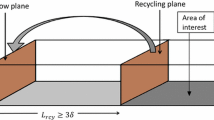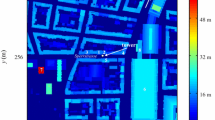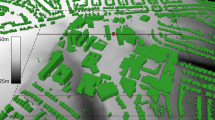Abstract
Large-eddy simulation (LES) is used to investigate the effects of building-height variability on turbulent flows over an actual urban area, the city of Kyoto, which is reproduced using a 2-m resolution digital surface dataset. Comparison of the morphological characteristics of Kyoto with those of European, North American, and other Japanese cities indicates a similarity to European cities but with more variable building heights. The performance of the LES model is validated and found to be consistent with turbulence observations obtained from a meteorological tower and from Doppler lidar. We conducted the following two numerical experiments: a control experiment using Kyoto buildings, and a sensitivity experiment in which all the building heights are set to the average height over the computational region \(h_{all}\). The difference of Reynolds stress at height \(z=2.5h_{all}\) between the control and sensitivity experiments is found to increase with the increase in the plan-area index (\(\lambda _p\)) for \(\lambda _p > 0.32\). Thus, values of \(\lambda _p\approx 0.3\) can be regarded as a threshold for distinguishing the effects of building-height variability. The quadrant analysis reveals that sweeps contribute to the increase in the Reynolds stress in the control experiment at a height \(z= 2.5h_{all}\). The exuberance in the control experiment at height \(z=0.5h_{all}\) is found to decrease with increase in the building-height variability. Although the extreme momentum flux at height \(z=2.5h_{all}\) in the control experiment appears around buildings, it contributes little to the total Reynolds stress and is not associated with coherent motions.















Similar content being viewed by others
References
Bou-Zeid E, Overney J, Rogers BD, Parlange MB (2009) The effects of building representation and clustering in large-eddy simulations of flows in urban canopies. Boundary-Layer Meteorol 132(3):415–436
Cañadillas B, Westerhellweg A, Neumann T (2011) Testing the performance of a ground-based wind LiDAR system: one year intercomparison at the offshore platform FINO1. Dewi Mag 38:58–64
Cheng H, Castro IP (2002) Near wall flow over urban-like roughness. Boundary-Layer Meteorol 104(2):229–259
Chorin AJ (1967) A numerical method for solving incompressible viscous flow problems. J Comput Phys 2(1):12–26
Christen A, van Gorsel E, Vogt R (2007) Coherent structures in urban roughness sublayer turbulence. Int J Climatol 27(14):1955–1968
Coceal O, Thomas T, Castro I, Belcher S (2006) Mean flow and turbulence statistics over groups of urban-like cubical obstacles. Boundary-Layer Meteorol 121(3):491–519
Coceal O, Dobre A, Thomas T, Belcher S (2007a) Structure of turbulent flow over regular arrays of cubical roughness. J Fluid Mech 589:375–409
Coceal O, Dobre A, Thomas TG (2007b) Unsteady dynamics and organized structures from dns over an idealized building canopy. Int J Climatol 27(14):1943–1953
Counihan J (1975) Adiabatic atmospheric boundary layers: a review and analysis of data from the period 1880–1972. Atmos Environ 9(10):871–905
ESDU (1985) Characteristics of atmospheric turbulence near the ground. Part II: single point data for strong winds (neutral atmosphere). ESDU International, London
Giometto M, Christen A, Meneveau C, Fang J, Krafczyk M, Parlange M (2016) Spatial characteristics of roughness sublayer mean flow and turbulence over a realistic urban surface. Boundary-Layer Meteorol 160(3):425–452
Goldstein D, Handler R, Sirovich L (1993) Modeling a no-slip flow boundary with an external force field. J Comput Phys 105(2):354–366
Inagaki A, Castillo MCL, Yamashita Y, Kanda M, Takimoto H (2012) Large-eddy simulation of coherent flow structures within a cubical canopy. Boundary-Layer Meteorol 142(2):207–222
Kaimal J, Wyngaard J, Izumi Y, Coté O (1972) Spectral characteristics of surface-layer turbulence. Q J R Meteorol Soc 98(417):563–589
Kanda M (2006) Large-eddy simulations on the effects of surface geometry of building arrays on turbulent organized structures. Boundary-Layer Meteorol 118(1):151–168
Kanda M, Moriwaki R, Kasamatsu F (2004) Large-eddy simulation of turbulent organized structures within and above explicitly resolved cube arrays. Boundary-Layer Meteorol 112(2):343–368
Kanda M, Inagaki A, Miyamoto T, Gryschka M, Raasch S (2013) A new aerodynamic parametrization for real urban surfaces. Boundary-Layer Meteorol 148(2):357–377
Macdonald R, Griffiths R, Hall D (1998) An improved method for the estimation of surface roughness of obstacle arrays. Atmos Environ 32(11):1857–1864
Nakajima C, Mitsuta Y, Tanaka M (1979) Ujigawa meteorological tower for boundary layer monitoring. Ann Disaster Prev Res Inst 22B(2):127–141
Nakayama H, Takemi T, Nagai H (2011) Les analysis of the aerodynamic surface properties for turbulent flows over building arrays with various geometries. J Appl Meteorol Clim 50(8):1692–1712
Nakayama H, Takemi T, Nagai H (2012) Large-eddy simulation of urban boundary-layer flows by generating turbulent inflows from mesoscale meteorological simulations. Atmos Sci Lett 13(3):180–186
Nakayama H, Leitl B, Harms F, Nagai H (2014) Development of local-scale high-resolution atmospheric dispersion model using large-eddy simulation. Part 4: turbulent flows and plume dispersion in an actual urban area. J Nucl Sci Technol 51(5):626–638
Nakayama H, Takemi T, Nagai H (2015) Large-eddy simulation of turbulent winds during the fukushima daiichi nuclear power plant accident by coupling with a meso-scale meteorological simulation model. Adv Sci Res 12(1):127–133
Nakayama H, Takemi T, Nagai H (2016) Development of LO cal-scale H igh-resolution atmospheric DI spersion M odel using L arge-E ddy S imulation. Part 5: detailed simulation of turbulent flows and plume dispersion in an actual urban area under real meteorological conditions. J Nucl Sci Technol 53(6):887–908
Oikawa S, Meng Y (1995) Turbulence characteristics and organized motion in a suburban roughness sublayer. Boundary-Layer Meteorol 74(3):289–312
Oke TR (1988) Street design and urban canopy layer climate. Energy Build 11(1):103–113
Park SB, Baik JJ, Han BS (2015) Large-eddy simulation of turbulent flow in a densely built-up urban area. Environ Fluid Mech 15(2):235–250
Ratti C, Di Sabatino S, Britter R, Brown M, Caton F, Burian S (2002) Analysis of 3-d urban databases with respect to pollution dispersion for a number of European and American cities. Water Air Soil Pollut Focus 2(5–6):459–469
Raupach M (1981) Conditional statistics of Reynolds stress in rough-wall and smooth-wall turbulent boundary layers. J Fluid Mech 108:363–382
Roth M (2000) Review of atmospheric turbulence over cities. Q J R Meteorol Soc 126(564):941–990
Shaw RH, Tavangar J, Ward DP (1983) Structure of the Reynolds stress in a canopy layer. J Clim Appl Meteorol 22(11):1922–1931
Smagorinsky J (1963) General circulation experiments with the primitive equations: I. The basic experiment. Mon Weather Rev 91(3):99–164
Stoll R, Porté-Agel F (2006) Effect of roughness on surface boundary conditions for large-eddy simulation. Boundary-Layer Meteorol 118(1):169–187
Wallace JM (2016) Quadrant analysis in turbulence research: history and evolution. Annu Rev Fluid Mech 48:131–158
Xie ZT (2011) Modelling street-scale flow and dispersion in realistic winds towards coupling with mesoscale meteorological models. Boundary-Layer Meteorol 141(1):53–75
Xie ZT, Castro IP (2009) Large-eddy simulation for flow and dispersion in urban streets. Atmos Environ 43(13):2174–2185
Xie ZT, Coceal O, Castro IP (2008) Large-eddy simulation of flows over random urban-like obstacles. Boundary-Layer Meteorol 129(1):1–23
Zaki SA, Hagishima A, Tanimoto J, Ikegaya N (2011) Aerodynamic parameters of urban building arrays with random geometries. Boundary-Layer Meteorol 138(1):99–120
Zhu X, Iungo GV, Leonardi S, Anderson W (2017) Parametric study of urban-like topographic statistical moments relevant to a priori modelling of bulk aerodynamic parameters. Boundary-Layer Meteorol 162:231–253
Acknowledgements
We thank three anonymous reviewers for their helpful comments and suggestions. We would like to express our deepest gratitude to Dr. Wim Vanderbauwhede at the University of Glasgow, who helped to create an MPI version of the code. We thank Dr. Hiromasa Nakayama at the Japan Atomic Energy Agency for his guidance on the LES modelling. We also thank Prof. Hajime Nakagawa of Kyoto University for conducting the field measurements at the Ujigawa Open Laboratory. This research partly used computational resources under the Collaborative Research Program for Young Scientists provided by the Academic Centre for Computing and Media Studies, Kyoto University. This study was supported by JSPS Kakenhi grant numbers 26282107 and 16H01846, and DPRI Collaborative Research 28H-04 and 29S-01.
Author information
Authors and Affiliations
Corresponding author
Electronic supplementary material
Below is the link to the electronic supplementary material.
Rights and permissions
About this article
Cite this article
Yoshida, T., Takemi, T. & Horiguchi, M. Large-Eddy-Simulation Study of the Effects of Building-Height Variability on Turbulent Flows over an Actual Urban Area. Boundary-Layer Meteorol 168, 127–153 (2018). https://doi.org/10.1007/s10546-018-0344-8
Received:
Accepted:
Published:
Issue Date:
DOI: https://doi.org/10.1007/s10546-018-0344-8




